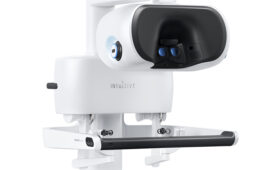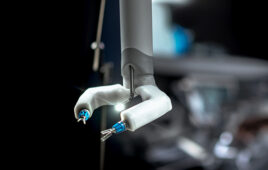
[Image from liz west on Flickr]
The researchers are developing control algorithms, imaging technology, ultrafast computational methods and human-machine immersion methods that could enable the steering of dozens or even thousands of tiny millimeter-sized robots through the human body – all with the help of an MRI scanner.
Traditionally, MRIs are used for non-invasive diagnosis. The UH and Houston Methodist Hospital scientists and doctors are hoping to use MRI technology for non-invasive or minimally-invasive treatment.
“We want to move from science fiction to science feasibility,” said Aaron Becker, assistant professor of electrical and computer engineering at the University of Houston (UH) and principal investigator, in a news release.
Nikolaos Tsekos, associate professor of computer science and director of the Medical Robotics Laboratory at UH, and Dipan J. Shah, a cardiologist and director of cardiovascular MRI at Houston Methodist Hospital, combined their shared expertise in MRI technology and assisted Becker on this research.
An MRI is a technique that uses a magnetic field and radio waves to give detailed images of the body, according to the Mayo Clinic. MRIs can also create 3D images of the body that can be viewed from different angles. They are usually performed so doctors can examine a patient’s organs, tissues and skeletal system.
Becker is building on his previous work in milli-robot development and control by building a prototype of milli-robots that could be controlled and tested in animals using Tsekos and Shah’s MRI control and computational methods.
The models they have built so far are 2 cm wide. The goal is to create robots that are anywhere from 0.5 mm to 2 mm wide.
MRIs generate enough magnetic forces to steer robots through blood vessels, but the robots cannot penetrate tumors or tissue. The scientists are working to overcome that challenge using the principle mechanical resonance and the self-assembling surgical tool, a Gauss gun.
Another issue the team has to overcome is speed. MRI scans are too slow to be able to control robots in blood vessels and present a time lag. Becker and his team are hoping to develop a system that is a multidisciplinary task that integrates the MRI scanner with milli-robot control and a looping system that can control the scanner to drive milli-robots.
Overcoming these challenges will hopefully bring them to their goal of using the power of an MRI to drive large numbers of robots in the human body, said Becker. They hope one of the robots could act as “microsurgeons” and target a single lesion to deliver chemotherapy.
“Targeting delivery with dozens of microsurgeons is my goal,” Becker said.
[Want to stay more on top of MDO content? Subscribe to our weekly e-newsletter.]






